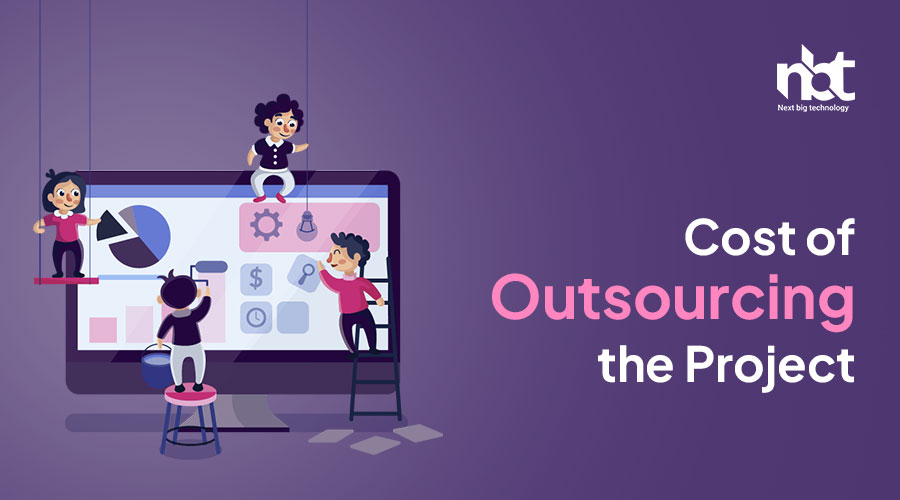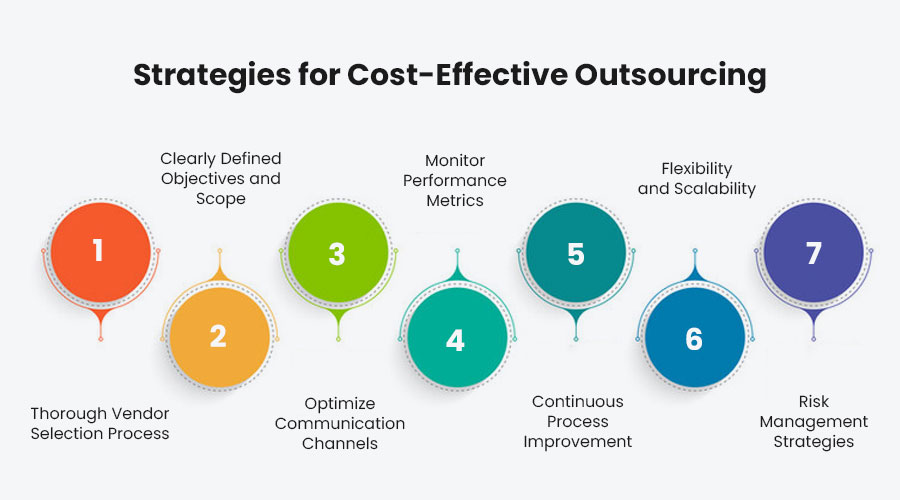Table of Contents
Understanding Outsourcing Costs
In the fast-paced world of business, outsourcing has become a prevalent strategy for companies aiming to streamline operations, reduce costs, and focus on core competencies. However, understanding the intricacies of outsourcing costs is essential for making informed decisions and maximizing its benefits. In this article, we’ll delve into the various factors that contribute to outsourcing costs, helping you navigate this complex landscape with confidence.
- Labor Costs: The primary driver of outsourcing expenses is labor costs. Depending on the location and expertise required, labor costs can vary significantly. Offshore outsourcing to countries with lower labor costs, such as India or the Philippines, can result in substantial savings compared to onshore or nearshore outsourcing options.
- Infrastructure and Technology Expenses: Beyond labor, outsourcing often entails additional expenses related to infrastructure and technology. These include setting up communication systems, software licenses, and data security measures. While these costs may seem daunting initially, outsourcing providers often leverage economies of scale to offer competitive rates.
- Quality and Expertise: Opting for the lowest-cost outsourcing provider may not always yield the best results. Consider the quality and expertise offered by different vendors, as higher-quality services may come at a premium. Investing in skilled professionals and robust processes can lead to better outcomes and long-term cost savings.
- Hidden Costs: It’s essential to factor in hidden costs associated with outsourcing, such as management overhead, training expenses, and legal fees. Failing to account for these costs upfront can lead to budget overruns and project delays. Conduct a thorough cost analysis to identify and mitigate potential hidden expenses.
- Risk Management: Outsourcing introduces inherent risks, including data breaches, regulatory compliance issues, and geopolitical instability. Assessing and mitigating these risks should be a crucial component of your outsourcing strategy. Consider partnering with reputable providers with a proven track record in risk management and compliance.
- Flexibility and Scalability: While outsourcing can offer cost savings, it’s essential to consider its impact on flexibility and scalability. Ensure that your outsourcing arrangements allow for scalability to accommodate changing business needs without incurring significant additional costs. Flexible contract terms and service level agreements can provide the agility needed to adapt to evolving circumstances.
- Total Cost of Ownership (TCO): Evaluating the total cost of ownership is paramount when assessing outsourcing options. TCO encompasses not only direct costs but also indirect costs, such as productivity loss, customer satisfaction, and brand reputation. By taking a holistic view of outsourcing costs, you can make more informed decisions that align with your strategic objectives.
Factors Influencing Outsourcing Costs
In today’s fast-paced business landscape, outsourcing has become a strategic necessity for many organizations aiming to streamline operations, reduce costs, and focus on core competencies. However, the decision to outsource comes with various considerations, one of the most significant being the cost involved. Understanding the factors influencing outsourcing costs is crucial for businesses to make informed decisions and optimize their outsourcing strategies effectively.
- Nature of Services: The type and complexity of services being outsourced significantly impact costs. Highly specialized services or those requiring advanced technical expertise may come at a higher price compared to routine tasks.
- Location of Service Provider: The geographical location of the outsourcing destination plays a pivotal role in determining costs. Offshore outsourcing to countries with lower labor costs, such as India or the Philippines, often results in more competitive pricing compared to onshore outsourcing.
- Labor Costs: Labor costs, including wages, benefits, and overheads, vary greatly across regions. Higher labor costs in developed countries may necessitate higher outsourcing rates compared to regions with lower living standards and wage expectations.
- Quality Standards: Maintaining quality standards is crucial for the success of outsourcing initiatives. Service providers offering superior quality assurance processes and certifications may charge higher rates for their services.
- Technology Infrastructure: Access to advanced technology infrastructure and resources can impact outsourcing costs. Providers equipped with state-of-the-art technology may charge a premium for their services, but they also offer greater efficiency and innovation potential.
- Regulatory Compliance: Compliance with regulatory requirements adds complexity to outsourcing arrangements, potentially increasing costs. Service providers adhering to stringent regulatory standards may charge higher fees to cover compliance-related expenses.
- Economic Factors: Economic conditions, exchange rates, inflation rates, and market dynamics influence outsourcing costs. Fluctuations in currency values can affect the overall cost-effectiveness of outsourcing arrangements, particularly in international outsourcing scenarios.
- Contractual Terms and Negotiation: The terms negotiated in outsourcing contracts significantly impact costs. Factors such as contract duration, volume discounts, service level agreements (SLAs), and payment structures can all influence the final outsourcing costs.
- Risk Management: Mitigating risks associated with outsourcing, such as data security breaches or service interruptions, often requires additional investments in risk management measures. Service providers offering robust risk mitigation strategies may charge higher rates to cover these expenses.
- Scalability and Flexibility: The scalability and flexibility of outsourcing arrangements impact costs over the long term. Providers offering scalable solutions that can adapt to changing business needs may command higher rates but offer greater value in terms of agility and responsiveness.
Initial Setup Expenses
Setting up a new venture or business requires meticulous planning and financial foresight. One of the crucial aspects to consider is the initial setup expenses. These expenses encompass various costs incurred at the outset of a business, including infrastructure, equipment, licenses, and more. In this article, we’ll delve into the intricacies of initial setup expenses, their significance, and how to manage them effectively.
- Identifying Key Components of Initial Setup Expenses:
- Infrastructure: This includes costs related to acquiring or renting office space, renovating or furnishing the premises, and setting up utilities like electricity, water, and internet.
- Equipment and Machinery: Businesses often require specialized equipment or machinery to operate efficiently. These expenses may involve purchasing computers, machinery, vehicles, or other tools necessary for production or service delivery.
- Licenses and Permits: Depending on the nature of the business, obtaining licenses, permits, or certifications from regulatory authorities is imperative. These expenses ensure legal compliance and smooth operations.
- Initial Inventory: For retail or manufacturing businesses, stocking up on initial inventory is essential. This may involve purchasing raw materials, finished products, or goods for resale.
- Estimating Costs Accurately:
- Conduct thorough research to determine the approximate costs associated with each component of the setup process.
- Seek quotations from multiple vendors or suppliers to compare prices and negotiate favorable deals.
- Factor in additional expenses such as taxes, shipping charges, installation costs, and contingencies to avoid budgetary surprises.
- Budgeting and Financial Planning:
- Create a detailed budget outlining all anticipated expenses along with their respective allocations.
- Prioritize expenses based on their criticality to the business’s operations and allocate funds accordingly.
- Consider seeking financial assistance through loans, grants, or investors to supplement your initial capital if needed.
- Managing Initial Setup Expenses Effectively:
- Opt for cost-effective alternatives where possible, such as leasing equipment instead of purchasing outright or choosing a shared office space to minimize rental costs.
- Negotiate payment terms with vendors or suppliers to stagger expenses and improve cash flow management.
- Regularly review and reassess your budget to track expenses and identify areas where cost-saving measures can be implemented.
- Importance of Contingency Planning:
- Despite careful planning, unexpected expenses or delays may arise during the setup phase. It’s crucial to have a contingency fund set aside to address such situations without derailing your business plans.
- Anticipate potential risks or challenges that could impact your budget and have strategies in place to mitigate them.
Labor Costs and Wages
In the realm of business economics, labor costs and wages stand as fundamental pillars shaping the operational landscape of enterprises. From small startups to multinational corporations, understanding the dynamics of labor costs and wages is crucial for sustainable growth and profitability. In this guide, we delve into the intricacies of labor costs and wages, exploring their significance, factors influencing them, and strategies for effective management.
The Significance of Labor Costs and Wages:
Labor costs and wages represent the expenditure incurred by businesses on employing human capital. They encompass not only the basic salaries paid to employees but also additional expenses such as benefits, insurance, and payroll taxes. For businesses, labor costs typically constitute a significant portion of total expenses, making them a vital consideration in budgeting and financial planning.
Wages, on the other hand, denote the compensation paid to employees in exchange for their work or services rendered. They serve as a primary incentive for individuals to participate in the workforce and play a crucial role in determining living standards and economic well-being. Moreover, wages influence consumer spending patterns, thereby impacting overall economic growth and demand for goods and services.
Factors Influencing Labor Costs and Wages:
Several factors contribute to the determination of labor costs and wages, including:
- Market Forces: The demand and supply dynamics of labor in the market play a pivotal role in determining wage levels. Industries facing a shortage of skilled workers may offer higher wages to attract talent, while those with surplus labor may witness downward pressure on wages.
- Legislation and Regulations: Government policies, such as minimum wage laws, overtime regulations, and labor standards, directly influence wage levels and labor costs. Compliance with these regulations is essential for businesses to avoid legal penalties and maintain ethical labor practices.
- Productivity and Skills: The productivity and skill level of workers significantly impact their earning potential. Highly skilled individuals with specialized expertise often command higher wages compared to those with basic qualifications.
- Cost of Living: Regional disparities in the cost of living influence wage disparities across different geographical areas. Employers operating in high-cost areas may need to offer higher wages to attract and retain talent.
- Unionization and Collective Bargaining: Labor unions play a crucial role in negotiating wages and benefits on behalf of workers. Collective bargaining agreements between employers and unions can influence wage levels and labor costs within specific industries or companies.
Strategies for Effective Management:
Managing labor costs and wages requires a strategic approach aimed at optimizing workforce efficiency while ensuring fair compensation for employees. Some key strategies include:
- Investing in Training and Development: Enhancing the skills and productivity of employees through training programs can contribute to higher efficiency and justify higher wage levels.
- Implementing Performance-Based Incentives: Linking compensation to performance metrics incentivizes employees to enhance their productivity and contribute to organizational goals effectively.
- Utilizing Technology and Automation: Embracing technology and automation can help streamline processes, reduce labor requirements, and mitigate the impact of rising labor costs.
- Monitoring and Controlling Overtime: Overtime expenses can significantly inflate labor costs. Implementing policies to monitor and control overtime hours can help minimize unnecessary expenses.
- Negotiating Cost-Effective Benefit Plans: Reviewing and renegotiating benefit plans to ensure cost-effectiveness without compromising employee satisfaction is essential for managing overall labor costs.
Cost of Materials and Resources
In the intricate web of economics and business operations, the cost of materials and resources serves as a critical determinant of profitability, sustainability, and competitiveness. Whether you’re a small business owner, a manufacturer, or a consumer, understanding the dynamics of these costs is essential. Let’s delve into this multifaceted topic and unravel its significance.
Materials and resources encompass a broad spectrum, ranging from raw materials like wood, metals, and minerals to energy resources such as oil, gas, and electricity. The cost of these inputs can vary significantly due to factors like market demand, supply chain disruptions, geopolitical tensions, and environmental regulations.
One of the primary factors influencing the cost of materials is supply and demand dynamics. When demand outstrips supply, prices tend to rise as suppliers capitalize on scarcity. Conversely, oversupply can lead to price reductions as suppliers compete for market share. Understanding these fluctuations is crucial for businesses to effectively manage their procurement strategies and pricing models.
Geopolitical factors also play a pivotal role in shaping material costs. Political instability, trade disputes, and sanctions can disrupt the flow of resources, leading to price volatility. For instance, tensions between major oil-producing nations can trigger fluctuations in oil prices, impacting industries reliant on petroleum-based products.
Moreover, environmental regulations and sustainability initiatives are increasingly influencing material costs. As governments impose stricter regulations to mitigate environmental impact, businesses may face higher compliance costs or invest in eco-friendly alternatives, affecting overall expenditure. Similarly, consumer preferences for sustainable products can drive up demand for environmentally friendly materials, thereby impacting prices.
Technological advancements also have a significant impact on material costs. Innovations in manufacturing processes or the development of alternative materials can disrupt traditional supply chains and alter cost structures. For instance, the emergence of 3D printing technology has revolutionized manufacturing by enabling the production of complex components at lower costs.
The cost of resources, particularly energy, is another critical aspect to consider. Fluctuations in oil and gas prices can have cascading effects across industries, influencing transportation costs, production expenses, and consumer prices. Renewable energy sources such as solar and wind power offer a more sustainable alternative, but initial investment costs and technological limitations may deter widespread adoption.
From a consumer perspective, the cost of materials and resources directly impacts purchasing decisions. Higher material costs often translate to increased product prices, affecting affordability and consumption patterns. Inflationary pressures driven by rising material costs can erode purchasing power, prompting consumers to seek more cost-effective alternatives or postpone discretionary spending.
Communication and Technology Costs
In today’s fast-paced digital landscape, effective communication is vital for the success of any business. With the rapid advancements in technology, the methods of communication have evolved significantly. From emails to instant messaging apps, video conferencing to social media platforms, businesses have a plethora of tools at their disposal to connect with clients, customers, and employees.
However, along with the benefits come the costs. Communication technology expenses can quickly add up, especially for small and medium-sized enterprises (SMEs) with limited budgets. Understanding and managing these costs is crucial for businesses to maintain efficiency and competitiveness in the market.
One of the primary costs associated with communication technology is infrastructure. Setting up and maintaining communication networks, servers, and hardware require a significant investment of both time and money. Additionally, there are ongoing expenses such as software licenses, updates, and cybersecurity measures to protect sensitive information from cyber threats.
Another major cost consideration is the subscription fees for communication tools and services. Whether it’s for email hosting, messaging platforms, or video conferencing software, businesses often have to pay recurring charges to access these essential services. While some offer affordable pricing plans, others can be quite expensive, especially for enterprises with large user bases.
Furthermore, there are hidden costs that businesses may overlook, such as training employees to use new communication technologies effectively. Time spent on training sessions and troubleshooting technical issues can impact productivity and add to the overall expenses.
Despite these challenges, investing in communication technology is essential for businesses to stay competitive and agile in today’s digital economy. It enables faster decision-making, improves collaboration among teams, and enhances customer service, ultimately leading to increased efficiency and profitability.
To optimize communication technology costs, businesses need to adopt a strategic approach. Firstly, they should conduct a thorough assessment of their communication needs and evaluate which tools are essential for their operations. By prioritizing functionalities that align with their business objectives, they can avoid unnecessary expenses on features they don’t require.
Additionally, businesses should explore cost-effective alternatives and negotiate with vendors for better pricing or discounts. Many communication service providers offer flexible pricing plans or discounts for long-term commitments, which can help businesses save money in the long run.
Moreover, implementing measures to improve efficiency and reduce waste can also contribute to cost savings. This could include optimizing network infrastructure, consolidating communication platforms, or implementing policies to minimize unnecessary communication.
Legal and Contractual Expenses
In the realm of business, legal and contractual expenses are indispensable components that warrant careful consideration. From drafting agreements to resolving disputes, these expenses encompass a broad spectrum of activities crucial for safeguarding the interests of individuals and organizations alike. In this article, we delve into the intricacies of legal and contractual expenses, shedding light on their significance and providing insights into optimizing their management.
The Importance of Legal and Contractual Expenses
Legal and contractual expenses serve as a shield against potential risks and uncertainties inherent in business transactions. Whether it’s negotiating terms, drafting agreements, or ensuring compliance with regulatory frameworks, legal expertise is indispensable. Contracts, in particular, lay down the foundation of business relationships, delineating rights, responsibilities, and recourse mechanisms. Investing in competent legal counsel not only mitigates risks but also bolsters the credibility and integrity of business dealings.
Components of Legal and Contractual Expenses
Legal and contractual expenses comprise various components, each serving distinct purposes. These may include attorney fees, court costs, contract drafting and review charges, litigation expenses, and settlement costs. Moreover, expenses associated with regulatory compliance, intellectual property protection, and risk management also fall under this ambit. Understanding the breakdown of these expenses is vital for budgeting and resource allocation, ensuring financial prudence and operational efficiency.
Strategies for Optimizing Legal and Contractual Expenses
Efficient management of legal and contractual expenses requires a strategic approach aimed at maximizing value while minimizing costs. Here are some strategies to consider:
- Proactive Legal Counsel: Engage legal counsel proactively to assess risks, review contracts, and provide guidance on compliance matters. Early intervention can prevent costly legal disputes down the line.
- Standardization of Contracts: Standardize contract templates wherever feasible to streamline the drafting process and minimize legal review expenses. Tailor contracts to specific requirements while maintaining consistency in key terms and provisions.
- Alternative Dispute Resolution (ADR): Explore alternative dispute resolution mechanisms such as mediation or arbitration to resolve conflicts outside the courtroom. ADR often offers a faster and more cost-effective means of dispute resolution compared to traditional litigation.
- Technology Integration: Embrace technology-driven solutions such as contract management software and electronic signature platforms to automate routine tasks, improve document accessibility, and enhance collaboration between stakeholders.
- Negotiation Skills: Invest in negotiation training for key personnel involved in contract negotiations. Strong negotiation skills can lead to favorable terms and mitigate the need for extensive legal interventions.
- Periodic Review and Audits: Conduct periodic reviews and audits of existing contracts to identify areas for optimization, renegotiation, or termination. Keeping contracts up-to-date ensures alignment with evolving business objectives and regulatory requirements.
Hidden Costs of Outsourcing
In today’s global economy, outsourcing has become a common strategy for businesses looking to cut costs, increase efficiency, and tap into specialized expertise. While outsourcing can offer numerous benefits, such as access to skilled labor and reduced overhead expenses, it’s essential for businesses to be aware of the potential hidden costs that may arise along the way. In this article, we’ll delve into some of the lesser-known expenses associated with outsourcing and offer insights on how to mitigate them.
- Communication Challenges: One of the most significant hidden costs of outsourcing is communication challenges. When working with remote teams or overseas vendors, language barriers, time zone differences, and cultural nuances can hinder effective communication. Misunderstandings and delays in communication can lead to errors, rework, and ultimately increased project costs. To address this, businesses should invest in clear communication channels, establish regular check-ins, and provide thorough project guidelines to ensure everyone is on the same page.
- Quality Control: Outsourcing certain tasks or processes can sometimes result in a loss of control over quality standards. While cost savings may initially seem appealing, poor quality work can lead to dissatisfaction among customers, damaged reputation, and ultimately, increased costs to rectify mistakes. To mitigate this risk, businesses should implement robust quality control measures, conduct regular audits, and provide adequate training and resources to outsourced teams.
- Legal and Compliance Risks: When outsourcing certain functions, businesses may unknowingly expose themselves to legal and compliance risks. This is especially true when outsourcing sensitive tasks such as data processing or customer support. Failure to comply with industry regulations or data protection laws can result in hefty fines, legal disputes, and damage to brand reputation. To safeguard against such risks, it’s crucial for businesses to thoroughly vet potential outsourcing partners, ensure they adhere to relevant regulations, and establish watertight contracts that clearly outline responsibilities and liabilities.
- Hidden Fees and Contractual Obligations: Another hidden cost of outsourcing lies in the fine print of contracts. Some outsourcing agreements may include hidden fees, unexpected charges, or stringent contractual obligations that can catch businesses off guard. It’s imperative for organizations to carefully review contracts, negotiate favorable terms, and seek transparency regarding all costs involved. Additionally, businesses should be prepared to invest time and resources into managing vendor relationships effectively to avoid potential disputes or misunderstandings.
- Dependency Risk: Relying too heavily on outsourcing partners can create dependency risk for businesses. If a key vendor goes out of business, experiences operational disruptions, or fails to deliver as promised, it can significantly impact the organization’s operations and bottom line. To mitigate this risk, businesses should diversify their outsourcing portfolio, maintain open communication with multiple vendors, and have contingency plans in place to address any potential disruptions.
Comparison with In-House Development Costs
In today’s digital age, businesses face critical decisions regarding their software development strategies. One of the primary considerations is whether to opt for in-house development or outsource the project to external vendors. Each approach has its own set of advantages and challenges, but a crucial factor that often tips the scales is cost.
Let’s delve into a comprehensive comparison of in-house development costs versus outsourcing to gain clarity on which path may be the most cost-effective for your business.
In-House Development Costs:
Building an in-house development team requires significant investment in both time and resources. Here are some key cost components associated with in-house development:
- Personnel Expenses: Hiring skilled developers, designers, project managers, and quality assurance professionals involves substantial expenses. Moreover, retaining top talent through competitive salaries, benefits, and training programs adds to the ongoing costs.
- Infrastructure Costs: Setting up and maintaining the necessary infrastructure, including hardware, software licenses, development tools, and office space, contributes to the overall expenditure.
- Time-to-Market: In-house development projects often entail longer development cycles due to resource constraints or skill gaps within the team. This extended time-to-market can result in increased opportunity costs and delayed revenue generation.
- Flexibility and Scalability: While having an in-house team offers greater control and customization, scaling the team up or down according to project requirements can be challenging and costly.
Outsourcing Costs:
Outsourcing software development to external vendors, whether onshore, offshore, or nearshore, presents a different cost structure. Here’s what you need to consider:
- Vendor Selection: Finding the right outsourcing partner involves thorough research and due diligence. While this upfront investment in vendor selection is essential, it can lead to long-term cost savings by ensuring quality and reliability.
- Project Pricing: Outsourcing contracts typically come with fixed or variable pricing models, depending on the scope and duration of the project. Negotiating favorable terms and clearly defining deliverables can help manage costs effectively.
- Reduced Overhead: By outsourcing development tasks, businesses can eliminate many overhead expenses associated with maintaining an in-house team, such as salaries, benefits, and infrastructure costs.
- Access to Specialized Talent: Outsourcing allows access to a global talent pool, enabling businesses to engage specialized developers with expertise in specific technologies or domains without the need for extensive training or recruitment efforts.
Factors Influencing the Decision:
When weighing the costs of in-house development against outsourcing, several factors come into play:
- Project Complexity: Complex projects requiring diverse skill sets may benefit from outsourcing, whereas simpler or highly specialized tasks could be more efficiently handled in-house.
- Time Constraints: If time-to-market is critical, outsourcing may offer a faster turnaround time by leveraging the scalability and expertise of external vendors.
- Strategic Focus: Businesses must consider whether software development aligns with their core competencies. Outsourcing non-core functions allows organizations to focus on their primary business objectives.
- Risk Management: Assessing risks such as data security, intellectual property protection, and vendor reliability is crucial in determining the feasibility of outsourcing.
Strategies for Cost-Effective Outsourcing
In today’s competitive business landscape, outsourcing has become a crucial strategy for companies looking to streamline operations, reduce costs, and gain access to specialized skills. However, outsourcing can also present challenges, particularly in terms of cost management. To ensure that outsourcing remains a cost-effective solution, businesses must implement strategies that optimize efficiency and minimize expenses. Here are seven effective strategies for cost-efficient outsourcing:
- Thorough Vendor Selection Process: Before outsourcing any task or process, it’s essential to conduct a comprehensive vendor selection process. Take the time to research potential outsourcing partners, evaluate their expertise, track record, and reliability. Look for vendors that offer competitive pricing without compromising on quality. Additionally, consider factors such as cultural fit, communication channels, and scalability to ensure a successful partnership in the long term.
- Clearly Defined Objectives and Scope: Clearly define your objectives and the scope of work before engaging with an outsourcing partner. By providing detailed project requirements and expectations upfront, you can avoid misunderstandings and scope creep, which can lead to cost overruns. A well-defined scope also enables vendors to provide accurate cost estimates and timelines, facilitating better budget management.
- Optimize Communication Channels: Effective communication is crucial for successful outsourcing relationships. Establish clear lines of communication with your outsourcing partner and leverage technology to facilitate collaboration. Utilize project management tools, video conferencing, and messaging platforms to ensure timely updates, feedback, and resolution of issues. By fostering transparent communication, you can minimize misunderstandings and delays, ultimately reducing costs.
- Monitor Performance Metrics: Implement performance metrics to track the progress and quality of work delivered by your outsourcing partner. Define key performance indicators (KPIs) relevant to your objectives, such as turnaround time, accuracy, and customer satisfaction. Regularly monitor these metrics and address any deviations promptly. By holding vendors accountable for their performance, you can ensure that resources are utilized efficiently and effectively.
- Continuous Process Improvement: Embrace a culture of continuous improvement within your outsourcing initiatives. Encourage feedback from both your internal team and outsourcing partner to identify areas for optimization and efficiency gains. Regularly review processes, workflows, and performance metrics to identify bottlenecks or inefficiencies. By continuously refining processes, you can enhance productivity and reduce costs over time.
- Flexibility and Scalability: Maintain flexibility and scalability in your outsourcing arrangements to adapt to changing business needs and market conditions. Choose vendors that offer flexible engagement models, allowing you to scale resources up or down as required. This flexibility enables you to align outsourcing expenses with your budget and demand fluctuations, optimizing cost-effectiveness.
- Risk Management Strategies: Develop robust risk management strategies to mitigate potential challenges associated with outsourcing, such as geopolitical risks, cybersecurity threats, or vendor instability. Conduct thorough due diligence on potential outsourcing partners, including their security protocols, compliance standards, and disaster recovery plans. Implement contractual safeguards and contingency plans to minimize the impact of unforeseen events on your operations and budget.
Top Cost of Outsourcing the Project Companies
In today’s dynamic business landscape, outsourcing projects has become a strategic move for companies aiming to leverage external expertise, reduce operational costs, and enhance efficiency. However, while outsourcing presents numerous benefits, it’s essential for companies to be aware of the associated costs to make informed decisions and maximize returns on investment. In this article, we delve into the top costs of outsourcing projects that companies should consider.
-
-
Next Big Technology:

Focus Area
- Mobile App Development
- App Designing (UI/UX)
- Software Development
- Web Development
- AR & VR Development
- Big Data & BI
- Cloud Computing Services
- DevOps
- E-commerce Development
Industries Focus
- Art, Entertainment & Music
- Business Services
- Consumer Products
- Designing
- Education
- Financial & Payments
- Gaming
- Government
- Healthcare & Medical
- Hospitality
- Information Technology
- Legal & Compliance
- Manufacturing
- Media
-
- Quality Assurance Expenses: While outsourcing projects can offer cost savings, ensuring the quality of deliverables often requires additional investment. Companies may need to allocate resources for quality assurance processes, including regular monitoring, performance evaluations, and feedback mechanisms. Neglecting quality assurance can lead to subpar outcomes, eroding the overall benefits of outsourcing.
- Communication and Collaboration Tools: Effective communication is key to successful project outsourcing. Companies may incur costs associated with implementing and maintaining communication and collaboration tools to facilitate seamless interaction between internal teams and external service providers. This includes expenses related to software subscriptions, training, and technical support.
- Legal and Compliance Costs: Outsourcing projects often involve legal agreements and compliance requirements that can incur additional costs. Companies may need to engage legal counsel to draft contracts, negotiate terms, and ensure compliance with relevant regulations and industry standards. Failure to address legal and compliance considerations upfront can result in costly disputes and penalties down the line.
- Infrastructure and Technology Investments: Depending on the nature of the outsourced project, companies may need to invest in infrastructure upgrades or technology solutions to support collaboration and data exchange. This could include implementing secure networks, cloud-based storage systems, or specialized software platforms tailored to the project requirements. While these investments can enhance efficiency and productivity, they also represent a significant upfront cost.
- Transition and Onboarding Expenses: When outsourcing projects, companies must allocate resources for the transition and onboarding process. This may involve training internal teams on new workflows, integrating external resources into existing systems, and establishing clear communication channels. Overlooking the importance of a smooth transition can lead to disruptions in operations and delays in project delivery.
- Risk Management and Contingency Planning: Outsourcing inherently introduces risks, ranging from vendor performance issues to geopolitical instability. Companies need to factor in the costs associated with risk management and contingency planning to mitigate potential disruptions and safeguard project outcomes. This includes conducting thorough risk assessments, developing contingency strategies, and establishing crisis response protocols.
FAQs On Cost of Outsourcing the Project
In the realm of business, outsourcing has become an indispensable strategy for companies aiming to streamline operations, cut costs, and access specialized expertise. However, uncertainties regarding the cost of outsourcing projects often linger in the minds of decision-makers. To provide clarity on this matter, let’s delve into some frequently asked questions about the cost of outsourcing projects.
- What factors influence the cost of outsourcing projects? The cost of outsourcing projects can vary significantly depending on various factors such as the complexity of the task, the expertise required, the location of the outsourcing partner, project duration, and the scope of services. Additionally, factors like currency exchange rates, market demand, and the reputation of the outsourcing provider can also influence costs.
- How do I determine the budget for outsourcing a project? Determining the budget for outsourcing projects involves a comprehensive analysis of your business needs, project requirements, and available resources. Start by outlining the scope of work, desired outcomes, and quality standards. Then, research prevailing market rates for similar services and consider the potential long-term benefits of outsourcing versus in-house execution. Collaborating with finance and procurement experts can also help in establishing a realistic budget.
- Are there any hidden costs associated with outsourcing projects? While outsourcing can offer cost savings, it’s crucial to be aware of potential hidden costs. These may include additional charges for revisions or changes in project scope, expenses related to communication and project management tools, and unforeseen expenses due to delays or quality issues. To mitigate such risks, ensure transparency in contracts, clarify pricing structures, and establish clear communication channels with the outsourcing partner.
- What are the cost-saving benefits of outsourcing projects? Outsourcing projects can yield several cost-saving benefits, including reduced overhead costs associated with maintaining in-house teams, access to skilled labor at competitive rates, scalability to match fluctuating project demands, and the opportunity to leverage economies of scale offered by outsourcing providers. Additionally, outsourcing can free up internal resources, allowing organizations to focus on core competencies and strategic initiatives.
- How can I ensure cost-effectiveness when outsourcing projects? To ensure cost-effectiveness when outsourcing projects, it’s essential to conduct thorough due diligence when selecting outsourcing partners. Look for providers with a proven track record, relevant experience, and a transparent pricing structure. Prioritize value over cost alone and establish key performance indicators (KPIs) to measure the effectiveness of the outsourcing arrangement. Regularly evaluate the performance of the outsourcing partner and be proactive in addressing any issues that may arise.
- What strategies can I employ to negotiate favorable outsourcing terms? Negotiating favorable outsourcing terms requires careful planning and negotiation skills. Start by clearly articulating your requirements and expectations, conducting competitive bidding processes to leverage market competition, and seeking concessions on pricing, terms, and service level agreements (SLAs). Focus on building a collaborative relationship with the outsourcing partner based on mutual trust and transparency to achieve mutually beneficial outcomes.
Thanks for reading our post “Cost of Outsourcing the Project”. Please connect with us to learn more about Best Outsourcing the Project.
























